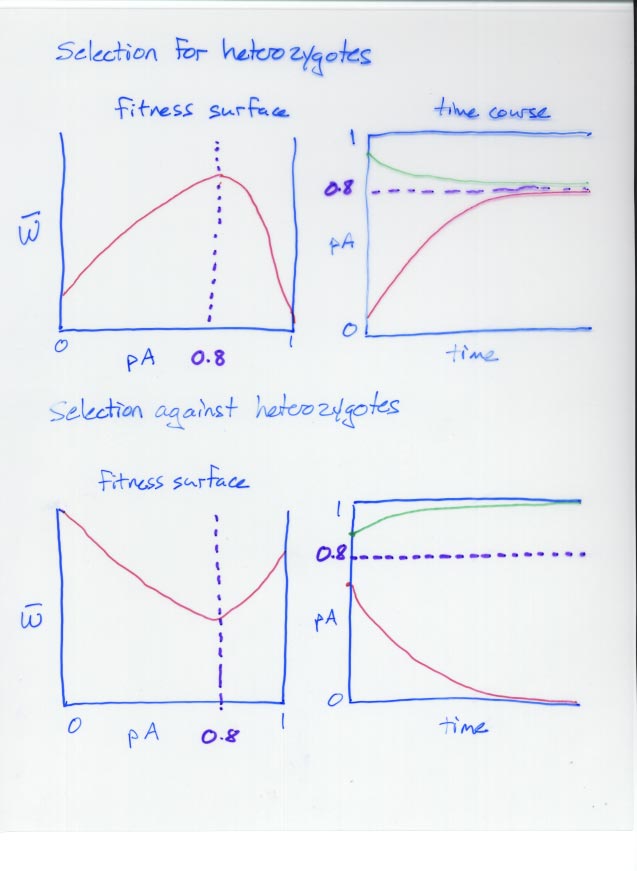Selection represents systematic differences in the chance that individuals will contribute genes to later generations. It can represent differences in survival or in reproduction.
The fitness of a genotype is measured relative to the fitness of an arbitrary reference genotype, normally the most fit. For example, the following shows a case in which dominant homozygotes and heterozygotes are most fit, and recessive homozygotes are much less fit, such as is seen for many recessive genetic diseases:
| genotype | AA | Aa | aa |
| fitness | 1.0 | 1.0 | 0.2 |
The fitness of an allele depends on what genotypes it finds itself in, so we can't determine it unless we know the genotype frequencies, or can estimate them using Hardy-Weinberg.
Note that the allele fitnesses will change if the allele frequencies change. A classic example is that a rare recessive has very little fitness effect even if it is lethal in the homozygote, because when it is very rare, it is almost never in homozygotes.
A population fitness less than 1 does not mean a dead population, just a population that is not reaching its maximum possible fitness.
An alternative way to write these is in terms of a selection coefficient-the proportion of fitness lost due to a particular genotype. Usually wAAis taken as a reference, waais assigned the selection coefficient s, and the fitness of the heterozygote is represented by a multiplier h.
| genotype | AA | Aa | aa |
| fitness | 1.0 | 1-hs | 1-s |
The multiplier h can then be thought of as a measure of dominance. h=1 means that a is dominant, h=0 means that it is recessive, h=0.5 means that it is perfectly additive.
Additive or Co-dominant
| genotype | AA | Aa | aa |
| fitness | 1.0 | 0.75 | 0.5 |
s = 0.5, h = 0.5. In this case p awill drop smoothly toward 0. Example: melanin in sunny climates.
Selection against Recessive
| genotype | AA | Aa | aa |
| fitness | 1.0 | 1.0 | 0.5 |
s = 0.5, h = 0. In this case p awill drop rapidly when a is common and then slow down, approaching 0 very slowly. The a alleles are hidden in heterozygotes and wabecomes very close to 1. Example: phenylketonuria.
Selection against Dominant
| genotype | AA | Aa | aa |
| fitness | 1.0 | 0.5 | 0.5 |
s = 0.5, h = 1. In this case p awill drop slowly when a is common (since there are few AA individuals competing with it) and speed up as a approaches 0. Example: Huntington's disease.
Overdominant and underdominant cases are usually written in terms, not of s and h, but of s1 and s2, selection against or for the two heterozygotes.
| genotype | AA | Aa | aa |
| fitness | 0.9 | 1.0 | 0.2 |
In this case p awill approach a value that maximizes W and stay there. Both A and a will persist in the population. The equilibrium point depends on wAAand waa(in this case, it's p A= 0.89, p a= 0.11). Examples: Sickle-cell anemia.
(If you're interested, the formula is:
p A= s2/(s1 + s2)
which basically says that the frequency of A depends on the proportion of the homozygous fitness loss that is due to a .)
| genotype | AA | Aa | aa |
| fitness | 1.0 | 0.8 | 1.0 |
In this case we cannot know what will happen unless we know where we started. If p Astarted out higher than 0.5 we will move to p A= 1.0. If it started out lower than 0.5 we will move to p A= 0.0. There is an equilibrium point at exactly 0.5 but it is unstable. Any least change will start the population moving to 1.0 or 0.0.
An interesting case is the following:
| genotype | AA | Aa | aa |
| fitness | 1.0 | 0.4 | 0.8 |
Here the population will move to all A or all a depending on starting frequency, which means that in some cases it will move to all a even though that is not the maximum possible fitness. Populations move to a local maximum, not the overall maximum. Example: butterfly mimics.
Directional and disruptive selection remove variation from the population, while balancing selection maintains it.
A population may evolve into a suboptimal state. With heterozygote advantage, the optimal state is unreachable for genetic reasons-there is no way to have only heterozygotes, short of a change in the genetic system. With heterozygote disadvantage, the optimal state is reachable but may not be reached if the starting conditions are wrong.

